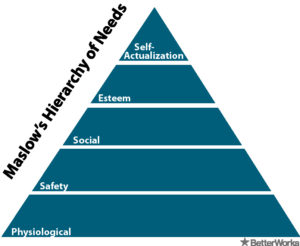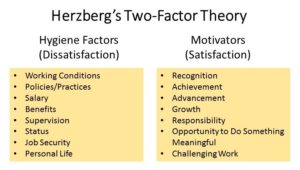Heart, not Head
Dreaming, aspiration, fear – these are all the most powerful motivators. Why? These are things of the heart. The research on Emotional Intelligence and Motivation is clear that things of the heart activate the oldest parts of our brain and excite us to action.
Bonuses can be the heartful motivator. But for most, even the top executives in organizations, profits and growth are only so exciting for so long. Something more than goals, more than the prospect of bonuses, and more than pep talks is needed to rally your team to new heights in 2017. What’s needed is a greater purpose.
Purpose Is Not New
Most business people know Maslow’s theory of motivation, or as it is often called, Maslow’s hierarchy of needs. Maslow created it way back in the 1940’s, over 70 years ago, way before iPhones and Snapchat. Even back them, Maslow knew what millennials know today. Money is only so motivating. It is a safety need – you need it to survive. That is why Maslow put the pursuit of money as a lower level motivator while he put self-actualization, or using your talents in a meaningful way, as the highest need of people.

Maslow’s Hierarchy of Needs shows that the pursuit of money is a lower-level motivator, while self-actualization, or using your talents in a meaningful way, is the highest need of people.
Then came the Herzberg model, based on extensive research in 1959. Herzberg went further and said money is a dis-satisfier. He found good salary would not motivate people to go above and beyond, but at best, not make people unhappy, and at worst create dissatisfaction. Even back then, the opportunity to do something meaningful, or purpose was found to be a motivator.

Herzberg said that the opportunity to do something meaningful (purpose) is a strong motivator.
Modern Purpose Proof
Daniel Pink’s bestselling book Drive is the most thorough modern compilation of motivation research. He found again, that beyond money, purpose is a top motivator (along with autonomy and mastery), especially for people doing complex work. The purpose motivated people when they had complex tasks to complete, much more than financial reward.

Daniel Pink in his book “Drive” asserts that beyond money, purpose is a top motivator.
Add in to that the modern workforce: the millennials. The most influential generation in the workforce right now are the Millennials. They are completely purpose driven. They are rooted in the NOW, knowing that no company will take care of them, that the economy is unstable and unpredictable, and that if they are spend 8 hours of their day at a job, they want to make a difference.
Purpose Propels People
Millennials know what Maslow and Herzberg knew long ago. Purpose is what drives people to higher levels. Think of the NASA teams who put men and shuttles into space. They weren’t working for the company – they were committed to the country, to science, to the mission of exploring new frontiers. If you think that’s the private reserve of space travel or the search for a cancer cure, look at the teams driving Amazon and Apple to turn missions into miracles.
Google did its own research and found that the most successful people in their companies were those that were “grateful,” or in other words, felt like their work has some kind of personal purpose.
Talk to people at Facebook and you will see they are not motivated by the free food and great pay. I have spoken to many, and they are not motivated to help you share cat pictures. They are motivated by the company’s greater purpose to make the world more open and connected. They are working hard and fast to create the next technological breakthrough so that they can connect the unconnected, in rural Africa and across the globe. This is what excites them to create new technical breakthroughs like completely rethought servers and data centers that have changed the infrastructure everywhere for the better.
So, what can you do?
The facts are clear that purpose is what will get your team to go beyond normal activity and excel daily to reach extraordinary heights. As the executive in charge you need to:
* Put Your Mission to the Purpose Test – I know some of you reading this will simply say “We have a mission statement and everyone is behind it.” Here’s a way to test your belief. First, ask everyone individually on your team what the mission is. I guarantee you will not get uniformity in answer. And even if you do, next examine what they say against the purpose test: Is the mission inspiring? Will it create a feeling of excitement to attempt to achieve? And will it create great personal satisfaction when you come close to achieving it? If not, you have more work to do.
* Dig for Purpose – Team missions build on the company mission but stand on their own. They often create more emotional attachment because they are closer to the daily work of your team. So, ask your team: “Why does our work matter to our customers, our stockholders, our colleagues, to you? What excites you about your job when you get up in the morning?” Listen carefully. Reflect collectively. It will take time and patience, and several iterations However, you will uncover the deeper emotional drivers of your work. This purpose will be the glue that unites you and the fuel that activates everyone to go above and beyond.
* Implant Purpose in Employees – Mark Zuckerberg talks about Facebook’s mission of making the world more open and connected every week. His employees told me he talks about it at least 2-3 times a week. Check for yourself. Look at his public Facebook posts and articles written about him. It is there. It is the repetition that will implant it hearts and minds.
* Create Purpose in a Minute – Purpose is not just for yearly meetings and posters. It motivates people in those places, but it must be more strategic than that. Millennials especially need constant reminders, lest they get lost in what seems like unimportant work. They want to make a difference in their work and life. The easiest way to do it is when you give them a new assignment, explain the impact this task is having on the project and how it will help if done and hurt if not done. All it takes is 60 seconds to get motivation based on purpose.
Autonomy, Mastery, Purpose image courtesy of Paul Downey via Creative Commons license.
Maslow’s Hierarchy of Needs image courtesy of BetterWorks (betterworks.com) via Creative Commons license.
https://creativecommons.org/licenses/by/2.0/legalcode





